|
Posted 11/18/21, edited 11/19/21
BACKING OFF
Leaving suspects alone cuts against the grain of policing.
But there are few options.

For Police Issues by Julius (Jay) Wachtel. Consider what life might be like today had Derek Chauvin and George Floyd never crossed paths on May 25, 2020. There would have been no reason to post “Punishment Isn’t a Cop’s Job” a mere nine days later, nor to ultimately devote a special section of the website to the tragic encounter and its profound consequences on American policing.
Nor, a couple months ago, to cancel a guest lecture at a local university because the professor wouldn’t let your writer play a video compilation of the police interaction with Mr. Floyd, from his arrest to the bitter end. In truth, given the tenor of these times, your writer’s advance warning that he agreed with officer Lane’s initial approach probably doomed the presentation.
Click here for the complete collection of strategy and tactics essays
Here our concern goes well beyond Floyd. We’ll take it one step at a time. First, when should officers become involved? Let’s review four notorious incidents, beginning with Mr. Floyd:
- George Floyd (Minneapolis, MN) It all began with a 9-1-1 call to MPD. Employees of a convenience store complained that a customer paid for a carton of cigarettes with a counterfeit bill, then wouldn’t make things right when he was approached as he sat in his car. They also reported that Mr. Floyd, who was at the wheel, appeared to be “on something,” meaning drugs.
- Karen Garner (Loveland, CO) In June 2020 Loveland police were called by a Walmart because an elderly woman tried to leave without paying for her items, then ripped off the Covid mask from an employee who intervened. Officers soon encountered the alleged assailant, Karen Garner, 73, as she “picked wildflowers” while walking home.
- Manuela Rodriguez (Long Beach, CA) Cops often initiate contacts based on what they observe. In a September 2121 “on view” incident in Southern California, Long Beach school police officer Eddie F. Gonzalez was on motorized patrol one block from a high school campus when he noticed that a young woman, later identified as Manuela Rodriguez, 18, was assaulting a 15-year old female student. Also present were Ms. Rodriguez’s 20-year old boyfriend and his brother, 16.
- Karon Hylton (Washington, D.C.) Traffic stops in high-crime areas are often conditioned on reasons other than traffic; say, suspicion of gang involvement or gun possession. One evening last month, while working a specialized anti-crime detail, D.C. police officer Terence Sutton observed a reputed gang member, Karon Hylton, 20, riding a moped on the sidewalk, without wearing a helmet. Suspecting that Hylton, whom he knew, “was armed and wanted revenge” over a recent clash, officer Sutton tried to stop him, ostensibly to issue a ticket.
Most officers would probably agree that the above situations are typical of what cops encounter each day. Of these, the in-progress assault on the teen seems the most worthy of prompt intervention. But the call about Mr. Floyd was also somewhat pressing: a local business had been victimized, the alleged evil-doer refused to make things right, and he was set to drive away while apparently impaired.
Beliefs about one’s role and obligations are intrinsic to all occupations. Police are committed to helping local businesses deal with shoplifters and unruly customers. Officers also expect that their colleagues will vigorously combat gangs and make life as miserable as possible for their members. So, what did the officers do? Let’s take each example in turn.
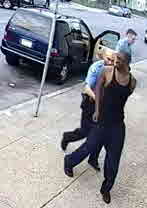 Pulling a gun isn’t pretty, but that’s what rookie MPD officer Thomas Lane did when Mr. Floyd seemed reluctant to step out of the car. As depicted in bodycam video, officer Lane soon had the drugged man out of the driver’s seat and in physical custody, avoiding further risks to citizens and police. Grimace if you wish, but in the everyday world of law enforcement, where citizens are often obstinate and all-too-frequently armed, that was a “success.” Pulling a gun isn’t pretty, but that’s what rookie MPD officer Thomas Lane did when Mr. Floyd seemed reluctant to step out of the car. As depicted in bodycam video, officer Lane soon had the drugged man out of the driver’s seat and in physical custody, avoiding further risks to citizens and police. Grimace if you wish, but in the everyday world of law enforcement, where citizens are often obstinate and all-too-frequently armed, that was a “success.”
While Mr. Floyd’s dereliction seems minor (he paid for his smokes with a counterfeit twenty), the large, unruly man presented a not-insubstantial physical threat. Store employees said that they last observed him sitting behind the wheel of a parked car, and that he seemed to be “on something.” It turns out that Mr. Floyd had a substantial criminal record, including a conviction for armed robbery. But we don’t know whether officers on scene knew, or when they found out.
As it turns out, Mr. Floyd was under the influence of powerful drugs. Had he been allowed to drive off he’d have imperiled innocent motorists. Officer Lane’s stern approach also avoided a risky pursuit. Mr. Floyd was promptly in handcuffs and on the sidewalk, where he threatened no one. So far, so good. When he later resisted getting into the back of a squad car, officers should have summoned a transport van. But their superior seemed intent on inflicting punishment. And we know how that turned out.
 Karen Garner’s encounter, on the other hand, went poorly from the start. According to the bodycam, when his command to stop was ignored, Loveland officer Austin Hopp gave no quarter to the woman’s age or clearly sketchy mental state (she suffers from dementia.) Instead, he grabbed the frail 73-year old from behind, twisted her arms and forcibly pushed her to the ground. Ms. Garner was promptly placed in a patrol car, taken to jail and booked for the $13.88 shoplift. Karen Garner’s encounter, on the other hand, went poorly from the start. According to the bodycam, when his command to stop was ignored, Loveland officer Austin Hopp gave no quarter to the woman’s age or clearly sketchy mental state (she suffers from dementia.) Instead, he grabbed the frail 73-year old from behind, twisted her arms and forcibly pushed her to the ground. Ms. Garner was promptly placed in a patrol car, taken to jail and booked for the $13.88 shoplift.
As one might expect, this episode didn’t end well for the city or the cop. Ms. Garner’s lawsuit was recently settled for $3 million. Officer Hopp is being prosecuted for assault, and an officer who assisted him has been charged with failing to report their colleague’s excessive use of force. Both have resigned.
Walmart employees likely realized that Ms. Garner had mental issues. (Click here for a video of what happened in the store.) However, we don’t know whether that concern was conveyed to 9-1-1. And when the responding officer encountered a recalcitrant, elderly person he immediately turned to force. Officer Hopp, 26, had only one year on the job. Perhaps he thought that Ms. Garner’s conduct required he make an arrest. Maybe he wanted an easy “stat.”
No matter. While the rookie’s decisionmaking skills might have eventually improved, sometimes there really is no second chance. Loveland police chief Robert Ticer quickly endorsed the cop’s prosecution. He also moved to increase de-escalation training and include a discussion of Alzheimer’s disease. Of course, persons such as Ms. Garner require an appropriate intervention the first time. To that end, an appropriate step would be to organize a dedicated mental health response team, perhaps using the popular “Cahoots” model.
 When the Long Beach school cop pulled up, Ms. Rodriguez promptly jumped into the front passenger seat of her companions’ car. Just as the trio set to leave, officer Gonzalez walked up and, gun at his side, ordered Ms. Rodriguez out. But the sedan abruptly sped off, nearly knocking the officer down. Officer Gonzalez fired at least twice, fatally wounding Ms. Rodriguez. (Click here for a video compilation.) When the Long Beach school cop pulled up, Ms. Rodriguez promptly jumped into the front passenger seat of her companions’ car. Just as the trio set to leave, officer Gonzalez walked up and, gun at his side, ordered Ms. Rodriguez out. But the sedan abruptly sped off, nearly knocking the officer down. Officer Gonzalez fired at least twice, fatally wounding Ms. Rodriguez. (Click here for a video compilation.)
Officer Gonzalez’s employment was promptly terminated and he was charged with murder. His qualifications have since come under scrutiny. He had reportedly two very brief stints with local police departments, one of which “chose to separate” him from his job.
Officer Gonzalez interrupted an assault. Yet when multiple persons are involved – the assailant was there with two male friends – trying to do it alone invites a blunder. We’re not opposed to drawing a gun and holding it to one’s side. But when a cop is at a great disadvantage – officer Gonzalez was outnumbered, on foot and lacked cover – should something happen a poorly thought-through, near-reflexive shooting becomes far more likely. Consider, for example, the tragic incident in Waukegan when an officer opened fire on a car he thought was purposely backing up on him, killing a passenger and wounding the driver. That’s why, as we mentioned in “An Illusory Consensus (Part II)”, many agencies have adopted PERF’s Guiding Principle No. 8, which prohibits shooting at moving vehicles “unless someone in the vehicle is using or threatening deadly force by means other than the vehicle itself” (p. 44, ed. 11/19/21).
 D.C. police rules have strictly restricted vehicular pursuits since at least 2003. According to Police Chief Peter Newsham, they’re presently forbidden for anything short of a felony. Karon Hylton, on the other hand, had observably committed nothing more than a traffic infraction. But he was reportedly a gang member. And when he refused to stop, the chase was on (click here for the video). Alas, Hylton soon collided with a van and was killed. (See 12/22/22 update.) D.C. police rules have strictly restricted vehicular pursuits since at least 2003. According to Police Chief Peter Newsham, they’re presently forbidden for anything short of a felony. Karon Hylton, on the other hand, had observably committed nothing more than a traffic infraction. But he was reportedly a gang member. And when he refused to stop, the chase was on (click here for the video). Alas, Hylton soon collided with a van and was killed. (See 12/22/22 update.)
In these days, with police literally “under the gun,” D.C.’s strict rules about chases are intended to avoid grossly disproportionate outcomes. As we recently mentioned in “Regulate,” foot pursuits have repeatedly led to bad endings. No matter that the lethal “blow” suffered by Mr. Hylton wasn’t delivered by a cop. Police officers must become accustomed to the notion that, as in virtually every other sphere of life (say, vaccination) individualism has triumphed over compliance. Policing can provoke all manners of unintended consequences, and simply because a citizen disobeys is no longer reason enough to use force.
So, when should cops act? In the “good old days” of Dragnet and Adam-12, politicians and the public seemed far more indulgent of officer skills and temperament. Allowances were typically made for the perils of the street and the little that cops may know about the characters and circumstances they face. Law enforcement is replete with ambiguity and uncertainty, and in the real world of the streets, crude responses are sometimes unavoidable. Over the last several years, though, the permissible margin of error has substantially narrowed. So while we’re not overly fond of rulemaking, strict guidelines such as D.C.’s can give officers, who labor under considerable peer and public pressure, defensible reasons not to act.
Be sure to check out our homepage and sign up for our newsletter
Of course, should cops become notably less proactive, criminals and evildoers may be emboldened. Pointing to recent increases in violence, some claim that’s already happened. Fine-tuning the police response so that our emerging notions of justice and equity aren’t breached and everyone is pleased has human and practical limits. And they’ve likely been reached.
UPDATES (scroll)
3/17/25 Last September a jury convicted D.C. police officer Terence D. Sutton Jr. and Lt. Andrew Zabavsky of covering up their roles in the death of Karon Hylton-Brown, 20, a reckless moped rider who was killed in a crash while fleeing. Both drew prison terms: Sutton, who was also convicted of 2nd. degree murder, got 5 1/2 years; Zabavsky got four years. But they were recently pardoned by President Trump. What’s more, D.C. Police Chief Pamela A. Smith just announced that an internal affairs inquiry has cleared both of the cover-up. So they’ve been reinstated. (See 9/25/24 and 12/22/22 updates)
12/10/24 Does getting cops off school campuses reduce racial and ethnic disparities in the criminal justice system? A new study revealed that ridding schools of police did reduce the reporting of school-based crimes. But the reduction wasn’t affected by a school’s racial or ethnic composition. By and large, neither were the school-based crime referrals and arrests that did take place. If there is bias in school crime reporting, simply removing cops isn’t a solution.
10/10/24 Three years ago then-Long Beach, Calif. school cop Eddie Gonzalez impulsively opened fire on a vehicle that was speeding away from a fight. One of his bullets struck and killed 18-year old Manuela Rodriguez, who had been involved in the brawl. Gonzalez was fired, charged with murder and locked up. A jury deadlocked in April, and he soon pled guilty to voluntary manslaughter. Prosecutors asked for six years but he drew three. And based on time served, he was just released on parole.
9/25/24 Former D.C. police officer Terence D. Sutton Jr. drew 5 1/2 years in prison, and former D.C. Lt. Andrew Zabavsky got four years over their roles in the unauthorized, protracted pursuit of Karon Hylton-Brown, 20, a reckless moped rider who was killed in a crash while fleeing. Both officers were convicted by a jury of lying to cover up their actions; Sutton, who led the chase, was also convicted of 2nd. degree murder. (See 3/17/25 and 12/22/22 updates)
5/3/24 Can police officers detain someone for simply trying to avoid them? Not according to the California Supreme Court. Reversing an appellate court opinion, the Justices agreed that such behavior can be considered as “relevant context”. Police are free to engage with citizens. But “before an officer can compel compliance with a show of authority, articulable facts must support a reasonable suspicion of criminal activity.” The case stemmed from LAPD’s detention of a man in a gang-infested area and the search of his vehicle, which turned up a gun and drugs. People v. Flores
10/31/23 D.C.’s carjacking problem has exploded to 828 so far
this year, 74% by gun. That’s far higher than the 399 during the same period last year. But in April 2023 the city passed an emergency ordinance restricting pursuits to situations where a
fleeing person “poses an imminent threat of death or serious bodily injury,” the pursuit is necessary “to protect another
person...from the threat of serious bodily injury or death”, and is “not likely to cause death or serious bodily injury to any
person, other than to the fleeing suspect or suspects”. Washington Post editors fear this policy change has contributed to the
rise.
12/22/22 A D.C. jury convicted police officer Officer Terence Sutton of 2nd. degree murder and both he and his superior, Lt. Andrew Zabavsky, of falsely justifying officer Sutton’s reckless, against policy pursuit of a moped rider in 2020. Karon Hylton-Brown, 20, was allegedly riding erratically, and collided with a vehicle during his flight from police. Jurors were not informed that Brown was on release, wearing an ankle monitor and carried over $3,000 in cash. (See 9/25/24 and 3/17/25 updates)
11/2/22 Concerns about the credibility of seven suspended members of a D.C. anti-gun squad will probably lead to the dismissal of “dozens of felony gun and drug cases.” Their bonafides came under suspicion after it turned out that the officers had been seizing guns but not making arrests, supposedly because they lacked proof as to who possessed the guns. It now turns out that body camera video from those encounters is inconsistent with their reports.
10/4/22 With his city beset by violence, D.C. Police Chief Robert J. Contee III acted promptly when he learned that seven members of an anti-crime unit didn’t arrest persons from whom they seized a gun. Each was relieved of duty. But the guns had been properly booked. According to the police union, prosecutors have refused to file charges when suspects claim guns are not theirs and physical evidence is lacking. DNA or fingerprint evidence may be needed. And its absence may be what held the cops back. (See above update)
9/26/22 A Fresno, Calif. man put a gun to his head and threatened to commit suicide and kill any police who approached. He was in his own home, and posed no immediate threat to others. So the officers left. With nearly one in four police shootings involving the mentally ill, “tactical disengagement” is being adopted by police across the U.S. Some agencies try to send in mental health professionals. But if there’s resistance to offers of help and innocents aren’t clearly at risk, everyone simply leaves.
9/20/22 Two years ago a high-speed pursuit of a fleeing carjacker by Chicago police led to a horrific crash and the death of an innocent motorist. Chicago has just agreed to settle the claim by the family of the victim, a 37 year old mother of six, for $15 million. Chicago has altered its pursuit policy to assure officers that they will not be disciplined for deciding not to chase. Chicago PD pursuit policy
9/12/22 Calling the shooting an “unnecessary tragedy” but citing a lack of proof of “wilfullness,” DOJ declined to charge former Overland Park, Kansas officer Clayton Jenison with civil rights violations in the 2018 killing of
John Albers, 17. Then-officer Jenison repeatedly fired on a vehicle that the reportedly suicidal teen aggressively backed from a garage which the officer had approached on foot. Jenison, who said he fired for fear of being struck, was cleared by a local prosecutor but soon resigned from the force. Jenison’s family settled with the city for $2.3 million. Video
8/6/22 Loveland, Co. officer Austin Hopp, who roughly handled Karen Garner, a 73-year old shoplifter with dementia, then joked about it with colleagues, was sentenced to five years imprisonment in May. For her failure to intervene, his partner, Daria Jalali, just got 45 days in jail. Loveland settled a suit with the family of Garner, who says the incident led to the woman to require 24-hour care, for $3 million.
6/10/22 On April 4 Grand Rapids (MI) police officer Christopher Schurr pulled over a car driven by Patrick Lyoya because its license plate didn’t match the vehicle. Lyoya ran away; the officer chased him onto a front lawn and they wrestled on the ground. A bodycam recorded the officer yelling that Lyoya took his Taser. The officer then fired his gun into Mr. Lyoya’s head, killing him. Protests promptly rocked the city. On April 9 Officer Schurr, a seven-year veteran, was charged with 2nd. degree murder. His personnel file shows no demerits for use of force “but much praise for traffic stops and foot chases that led to arrests and the seizure of guns and drugs.” Police press conference and bodycam video
11/20/21 On November 19, a jury found L.A. sheriff’s deputy Luke Liu not guilty of manslaughter. In 2017 Liu shot and killed Francisco Garcia, who was driving a stolen car, when Garcia suddenly pulled away after telling the deputy that the vehicle’s ownership was “none of his business.” Liu claims the vehicle struck his knees, and that he fired in self-defense. L.A. Sheriff’s policy generally prohibits shooting at vehicles unless a weapon other than the vehicle is being used.
|
Did you enjoy this post? Be sure to explore the homepage and topical index!
Home Top Permalink Print/Save Feedback
RELATED POSTS
Stop & Frisk/Hot Spots special topic George Floyd special topic
A Lethal Distraction Putting Things Off Forewarned is Forearmed
Punishment Isn’t a Cop’s Job (III) What Cops Face Tenacity is Great - Until it’s Not
In Two Fell Swoops Woke up, America! Regulate. Don’t “Obfuscate.”
Third, Fourth and Fifth Chances L.A. Wants “Cahoots” When Must Cops Shoot? (I)
An Illusory Consensus (II) De-Escalation Traffic Stops Aren’t Just About “Traffic”
Posted 8/24/21
A PARTNER IN EVERY SENSE
When a K-9 is stabbed its handler opens fire. It’s not the first time.
For Police Issues by Julius (Jay) Wachtel. There’s no question that the 9-1-1 call merited an urgent response. Actually there were two calls, whose timing overlapped. Fullerton (Calif.) police released a comprehensive video account of the May 27, 2020 incident that includes conversations between 9-1-1, callers and field units. Here are a few extracts:
First call
FPD 9-1-1, police
Caller Um, yeah...um, my emergency is my stepdad hit my
brother, and they’re fighting right now...He has a knife!
Hurry up!
FPD Who has the knife?
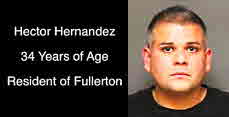 Caller The owner of the house... stepdad...Hector Hernandez. Caller The owner of the house... stepdad...Hector Hernandez.
...come fast...(gunshot and screaming in background)
Caller He pulled out a gun on me. He just tried shooting!
FPD Where is Hector right now? Is he still in the house or is
he outside?
Caller No. He is out in the courtyard screaming...He’s just
drunk...he’s drunk
FPD And as far as you know, nobody’s been injured?
Caller No
Second call
FPD 9-1-1 Fullerton police; what is your emergency?
Caller Hello, I think I heard gunshots...
FPD Where? Where are you? Where are you? (caller provides address)
FPD We have officers on the way there...How many gunshots...?
Caller ...please get in here...How many gunshots? Four or five...
Dispatcher to units
We can hear screaming in the background now...
R/P (reporting party) is now saying the subject is armed with a gun. And fired the gun...
R/P’s advising that the subject went back inside the house...
And we also have neighbors calling confirming shots fired...
They’re advising Hector is inside the res...and his 8-year old and a 13-year old are also inside.
Click here for the complete collection of strategy and tactics essays
Fullerton’s video includes footage from the K-9 officer bodycam. As he drives up Mr. Hernandez exits the residence and positions himself by the front door. Multiple officers are present as the K-9 cop takes the lead. He promptly releases “Rotar,” who initially runs the wrong way. After redirecting the pooch, the officer points his pistol at Mr. Hernandez and follows behind. As the dog leaps on Mr. Hernandez the officer orders him to “get on the ground!” (third image). Instantly something bad happens (Mr. Hernandez stabs the dog.) The officer yells “let me see your hands!” and fires his gun (fifth image.) As Mr. Hernandez screams in agony the officer announces, “he’s got a knife!” (sixth image) and fires again.
 |
 |
Mr. Hernandez writhes in pain. Officers run up and drag “Rotar” away. In a later clip the K-9 cop tells a colleague “I think [the dog] has been stabbed.” When asked if the K-9 is “OK” he replies “I don’t know. He was stabbed and then he [Mr. Hernandez] started going after me.” Of that we’ve seen no video. But there was a knife (see top graphic) and the dog’s wound (right graphic) was grisly. Fortunately, he survived and retired. And while it turned out that Mr. Hernandez hadn’t been carrying a gun on his person, police found the pistol he had fired inside the home. Fortunately, he survived and retired. And while it turned out that Mr. Hernandez hadn’t been carrying a gun on his person, police found the pistol he had fired inside the home.
Alas, such things have happened before. In February, 2020 Saginaw (MI) police were summoned to a home where a mentally ill man held a housemate at knifepoint. Officers physically tangled with the assailant and freed his companion. But despite being stunned with a Taser, the knife-wielding man broke loose and retreated deep into the home. A K-9 was sent in to flush him out. But when the dog took him down, the evildoer stabbed him in the head. Knife in hand, the suspect started to rise. That’s when an officer shot him dead. Prosecutors ruled the killing “justified and consistent with preservation of self and others”:
Officer Adams was within reach of Blaisdell, Blaisdell remained in control of a large knife, he had just stabbed a police canine with the knife, and his movements indicated that he was attempting to get up from the ground. Officer Adams reported that he was in fear for his own safety; Officer Engelhart reported that he feared for Officer Adams’s life.
Still, the assailant’s mother sued, and the city ultimately settled for $510,000.
Saginaw’s K-9 recovered and returned to the job. Alas, not K-9 “Aren.” In January 2016 he was stabbed and killed by an angry, knife-wielding man during a ferocious fight with officers in Wilkinsburg (PA). They, too, wound up shooting and killing the man, and prosecutors deemed their actions justified. Family members filed a Federal lawsuit. Although a trial judge tossed it out, an appellate court questioned the cops’ lethal response and reinstated the case, which is apparently still pending.
Back to Fullerton. On July 21, 2021, fourteen months after Mr. Hernandez’s death, Orange County prosecutors issued a highly detailed, sixteen page report. Here's an extract:
As Corporal Ferrell reached with his left hand towards Rotar to get Rotar off the bite, Corporal Ferrell physically reacted to seeing the knife...Corporal Ferrell jerked his body away from Rotar and Hernandez. This is when the first shot was fired by Corporal Ferrell. At the time of the shot, Corporal Ferrell was less than one foot away from Hernandez and within arms’ reach of Hernandez [thus] close enough to be stabbed...The BWC shows Corporal Ferrell yelled, “He’s got a knife!” Corporal Ferrell was still within...arm’s reach of Hernandez when he fired the second shot...
Prosecutors arrived at essentially the same conclusion as their colleagues in Michigan and Pennsylvania:
Hernandez’ conduct captured on BWC would prevent the prosecution from proving beyond a reasonable doubt that Corporal Ferrell was not justified in believing he was in imminent fear of suffering great bodily injury and/or death at the time he discharged his service weapon.
Mr. Hernandez’s family was outraged. Their lawyer, Garo Mardirossian, who represents them in a lawsuit, argued that Mr. Hernandez never posed a threat to the officer. Instead, he was just trying “to protect himself from being mauled by a dog”:
He’s just got his hands up the whole time, then they release the dog...A 2-inch or 3-inch pocket knife in your pocket is not illegal. And even then, he did not touch that pocket knife and pull it until after the dog was mauling him. And you have a right to grab whatever you can...to stop excessive, illegal use of force against you...
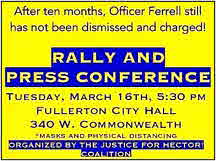 Bill Brown, a friend of Mr. Hernandez and member of the “Justice for Hector Hernandez coalition” argued that the K-9 officer only fired because of what was happening to his dog: Bill Brown, a friend of Mr. Hernandez and member of the “Justice for Hector Hernandez coalition” argued that the K-9 officer only fired because of what was happening to his dog:
“I mean he just got totally reckless because it was like he just got tunnel vision. He focused on, ‘Oh, my God, he’s hurting my dog, I’m gonna stop him now ...’ That’s exactly what it seems like happened — he lost all control of his training and reasonable thinking and just decided, I need to do this.”
Mr. Brown’s assessment isn’t unreasonable. After all, if someone is stabbing your pet, and you have a gun in hand, what might you impulsively do? Yet police had been called because Mr. Hernandez was acting crazy and firing a gun. Every officer on scene must have worried that he was still “packing.” Canine handlers are especially exposed to harm. That’s why the IACP urges that they be protected by a “cover officer”:
Be sure to check out our homepage and sign up for our newsletter
...the cover officer is usually responsible for providing cover while the handler devotes his or her concentration to the activity of the canine...Cover officers are essential if the suspect is located because the handler alone cannot safely secure both the canine and suspect or manage the canine while conducting a search of the suspect...(p. 12)
Fullerton’s K-9 handler seemed eager to seize the opportunity to collar the man. Had he waited Mr. Hernandez might have gone back in the house, endangering its occupants and making his capture far more risky and problematic. So the officer rushed in with just his canine partner. That was inherently dangerous, so he kept his pistol trained on Mr. Hernandez. Such tactics cut both ways. As we mentioned in “Speed Kills”, examples abound of lethal errors committed by officers in a hurry. Officer personalities and skill sets also vary. Cops who are “easily rattled, risk-intolerant, impulsive or aggressive” are use-of force disasters waiting to happen.
However, we’re just speculating. Fullerton PD’s published rules for canine deployment don’t mention the use of cover officers. We also know nothing about this K-9 cop. Whether things might have turned out more peaceably in another agency or with a different dog handler is impossible to say. What can be said is that when assessed from the perspective of Graham v. Connor’s “reasonable officer,” Mr. Hernandez’s behavior clearly set the stage for a tragic ending. Perhaps a poor outcome was inevitable; perhaps not. But sometimes you really, really can’t simply blame it on the cops.
UPDATES (scroll)
6/9/23 As the George Floyd saga recedes in time, police find they have a stronger voice in shaping the rules that affect their practices. Two proposed California laws that cops bitterly contested - one that bars using canines “unless there’s a threat of imminent death or serious bodily injury”, and another that prohibits asking for “consent searches” during traffic stops - were removed from the hopper. And a proposed ban on minor traffic stops would now allow them if officers have two or more reasons.
2/22/23 According to the text of a proposed new California law, “the use of police canines has been a mainstay in the constant dehumanizing, cruel abuse of Black Americans and people of color in this country.” Citing data that Black persons “are 3.5 times more likely than any other groups” to be bitten by K-9’s, Assembly Bill 742 would prohibit their use in making arrests, crowd control, or any other situation in which they could bite. They could continue to be used for drug and explosives detection.
|
Did you enjoy this post? Be sure to explore the homepage and topical index!
Home Top Permalink Print/Save Feedback
RELATED POSTS
When Must Cops Shoot? (I) (II) Speed Kills Three Inexplicable Shootings When Cops Kill (I) (II)
Posted 6/13/21
REGULATE. DON’T “OBFUSCATE”.
Tailor remedies to the workplace. And keep it real!
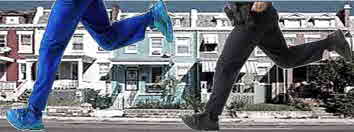
For Police Issues by Julius (Jay) Wachtel. Chasing after suspects on foot isn’t something that should be thoughtlessly encouraged. In “Want Happy Endings?” we emphasized that such pursuits often end tragically. Our example, the June 18, 2020 shooting death of an armed eighteen-year old by Los Angeles County sheriff’s deputies might have been resolved far more peacefully had officers sought to contain the youth and called for backup.
That’s not the first time we’ve questioned foot chases. Over a decade ago we summarized the problem thusly:
[Foot chases] place officers in unfamiliar surroundings. Often alone, lacking access to the normal tools of policing, they get wholly dependent on their guns for survival. Pumped up on anxiety and adrenaline, with little opportunity to observe or reflect, it’s inevitable that their split-second decisions will occasionally prove to be tragically wrong...Unless academies can produce Supercops who are unaffected by stress and fatigue and can see in the dark, prohibiting one-on-one foot pursuits may be the only option.
Click here for the complete collection of strategy and tactics essays
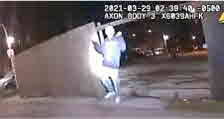 Foot pursuits with tragic endings aren’t just a problem in Southern California, where that essay focused. During the early morning hours of March 29, 2021 a shot-spotter device alerted Chicago police to gunfire. Two officers promptly arrived. An adult male and his young teen companion took off on foot, and the chase was on. A cop promptly corralled Ruben Roman, 21. Surveillance video would later confirm that the alleged gang member was indeed the shooter (but see 11/19/22 update). Alas, he had apparently passed the gun to the youth, who kept on running. After a prolonged chase, the other cop cornered him. Adam Toledo tossed the gun and raised his arms as if to surrender (see image). But as he did so the officer opened fire and shot the youngster dead. (Click here for our half-speed version of the pursuit’s final moments and here for the official collection of videos of the encounter.) Foot pursuits with tragic endings aren’t just a problem in Southern California, where that essay focused. During the early morning hours of March 29, 2021 a shot-spotter device alerted Chicago police to gunfire. Two officers promptly arrived. An adult male and his young teen companion took off on foot, and the chase was on. A cop promptly corralled Ruben Roman, 21. Surveillance video would later confirm that the alleged gang member was indeed the shooter (but see 11/19/22 update). Alas, he had apparently passed the gun to the youth, who kept on running. After a prolonged chase, the other cop cornered him. Adam Toledo tossed the gun and raised his arms as if to surrender (see image). But as he did so the officer opened fire and shot the youngster dead. (Click here for our half-speed version of the pursuit’s final moments and here for the official collection of videos of the encounter.)
 Two days later, on March 31, it was Déjà vu all over again. For unconfirmed reasons – their quarry had supposedly eluded them a day earlier – two Chicago police officers furiously chased a twenty-two year old man through a residential area at about one in the morning. Anthony Alvarez entered a townhome complex, and as he reached a set of stairs an officer opened fire and shot him dead. Video footage provided and edited by Chicago PD supposedly shows that during the chase Alvarez produced a gun, which some say he dropped just before the shooting (the videos aren’t clear about that.) In fact, his pistol was recovered; best we can tell, though, Alvarez never pointed it at his pursuers. (Click here and here for our extracts from Chicago PD bodycam videos.) Two days later, on March 31, it was Déjà vu all over again. For unconfirmed reasons – their quarry had supposedly eluded them a day earlier – two Chicago police officers furiously chased a twenty-two year old man through a residential area at about one in the morning. Anthony Alvarez entered a townhome complex, and as he reached a set of stairs an officer opened fire and shot him dead. Video footage provided and edited by Chicago PD supposedly shows that during the chase Alvarez produced a gun, which some say he dropped just before the shooting (the videos aren’t clear about that.) In fact, his pistol was recovered; best we can tell, though, Alvarez never pointed it at his pursuers. (Click here and here for our extracts from Chicago PD bodycam videos.)
Given the gunplay that typically rocks Chicago, the lethal encounter with Mr. Alvarez, an adult, was vastly overshadowed by the shooting death of thirteen-year old Adam Toledo. So just why was a boy running around with an armed felon at two-thirty in the morning? One-time Chicago police commissioner Garry McCarthy (he was chief through 2015) blamed the child’s violent death on the gang members that infest his city. “They have the ‘shorties’ who they give the gun to,” he told WBBM radio. Former Commissioner Eddie Johnson, a Black officer who succeeded McCarthy, offered the officer who killed the boy some words of support:
...I don’t see anything that would dictate that the officer would be prosecuted for anything. It’s a tragedy. All of this happened in less than a second...Tossing a weapon and turning around in a split second doesn’t give your brain time enough to process. Reality isn’t like Hollywood. It’s much different...
Outside the law enforcement community such “explanations” fell on deaf ears. Adam Toledo’s killing was widely and near-reflexively condemned. “It could have been any one of my students,” said an eight-grade teacher. “I don’t think there’s enough training for cops, especially white cops dealing with Black and brown kids,” she added. “They’re acting out of fear.” Chicago Tribune columnist Rex Huppke summarized the prevailing sentiment in an uncompromising piece:
There is only one side here, and it’s a side that should be almost instinctual in all of us as human beings, a thread woven into our DNA: What we saw in that police body camera video is wholly, wildly, unnaturally unacceptable.
Perhaps sensing a very ill wind, city officials quickly jumped on the bandwagon. Instead of pointing fingers at the officer – his predicament, we suspect, was too complex and legally charged to allow for a tidy scolding – they blamed police policies. Those, they pledged, would be promptly reformed. Mayor Lori Lightfoot demanded it: “We cannot and will not push the foot pursuit policy reform off for another day.”
Full stop. By “reform” she must have meant meant “change.” Chicago P.D. had issued a foot pursuit policy in January 2018. Revised last year, the rules comprehensively set out the requirements and justifications for a foot chase. A prominently boxed warning informs officers that foot pursuits are only authorized when there is “reasonable articulable suspicion to conduct an investigatory stop or probable cause to arrest.” Officers are sternly reminded about the risks that foot chases present to everyone, including the suspect. They’re advised to exercise great caution in deciding whether and how to pursue and discouraged from giving chase except in cases of violent crime. Among other things, officers are instructed to interact with suspects in ways that prevent flight, warned against separating from colleagues, and urged to contain fleeing persons by establishing a perimeter. Use of force, including deadly force, is addressed at some length. Here’s an outtake:
Deadly force may not be used on a fleeing subject unless the subject poses an imminent threat of death or great bodily harm to the officer or another person. Force used on a subject who is fleeing, or who is being or has been apprehended, must, as in all use of force, be objectively reasonable, necessary, and proportional.
In all, the advice seems fully consistent with Supreme Court decisions about pursuits (e.g., U.S. v. Arvizu) and use of force (e.g., Graham v. Connor.)
 But then police shot and killed a boy. Two months later, on May 26, the mayor and Commissioner Brown announced a new, comprehensive foot chase policy. (Click here for its “highlights,” here for its full text, and here for our compilation.) And be sure to grab a snack. With a word count of 5,777 it’s about three times the length of the original version. (By way of comparison, the foot pursuit policy of the La Verne police department, which the L.A. County Police Chief’s Association recently cited as a model in Lange v. California, takes about 1,613 words. But then police shot and killed a boy. Two months later, on May 26, the mayor and Commissioner Brown announced a new, comprehensive foot chase policy. (Click here for its “highlights,” here for its full text, and here for our compilation.) And be sure to grab a snack. With a word count of 5,777 it’s about three times the length of the original version. (By way of comparison, the foot pursuit policy of the La Verne police department, which the L.A. County Police Chief’s Association recently cited as a model in Lange v. California, takes about 1,613 words.
Its massiveness aside, Chicago PD’s new foot chase policy is a polished piece. While it studiously avoids mentioning the assumedly “bad, old” directive the policy addresses most of the same concerns. Its advice, though, is far more detailed. For example, the perils of becoming separated from one’s partner, or of running with a firearm in hand, are set out in police-academy precision. Ditto coordinating pursuits with superiors and support staff. When it comes to rulemaking, the policy considers issues that transcend chases. For example, it specifically prohibits using force “as punishment or retaliation (e.g., force used to punish or retaliate for fleeing or resisting arrest)”. Throughout, many examples are given to demonstrate how the rules would apply to a variety of field situations
So Chicago got its money’s worth, right? Not according to its embattled police union president. John Catanzara complained that the new rules in fact amount to a “no-foot-pursuit policy” that could preclude chases altogether. Mr. Catanzara, a suspended officer who endorsed the Capitol assault, is no friend of city hall. Yet his concerns can’t be easily dismissed. While the original policy didn’t require that suspected criminal behavior meet any certain level of severity to justify a chase, its replacement forbids foot chases when “the established reasonable articulable suspicion or probable cause is solely for a criminal offense less than a Class A misdemeanor (a sentence of less than one year of imprisonment) and the person...poses no obvious threat to the community or any person [or] has no obvious medical or mental health issues that pose a risk to their own safety.”
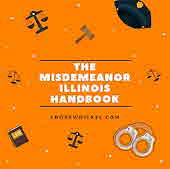 Mr. Catanzara’s objection brings up our recurring emphasis on the police workplace. Consider the rapidly-changing, stressful situations that officers often encounter. If they happen on a lawbreaker who suddenly bolts, must they instantly and precisely assess the severity of his conduct – say, class of misdemeanor – before chasing? (Say, maybe they could carry this handbook!) To this long-retired practitioner that seems a bit of a stretch. Happily, the new policy adopts the flexibility of the original rule’s “Whether to Pursue” section by making special allowances should a suspect pose an “obvious” threat. Mr. Catanzara’s objection brings up our recurring emphasis on the police workplace. Consider the rapidly-changing, stressful situations that officers often encounter. If they happen on a lawbreaker who suddenly bolts, must they instantly and precisely assess the severity of his conduct – say, class of misdemeanor – before chasing? (Say, maybe they could carry this handbook!) To this long-retired practitioner that seems a bit of a stretch. Happily, the new policy adopts the flexibility of the original rule’s “Whether to Pursue” section by making special allowances should a suspect pose an “obvious” threat.
Across from Mr. Catanzara sit the civil libertarians. And they object to the new regulations for precisely the opposite reason. Given cops’ self-interest, accommodating the rules of the chase to the workplace could in practice mean that no rules exist. Here’s how Illinois ACLU legal director Nusrat Choudhury feels about the new version:
It’s vague and at times even self-contradictory. But what a policy needs to do is give clear and easy to understand guidance on when not to chase someone on foot. When you look closely it is not going nearly as far as it should…even with the bar on Class A...I think this policy leaves a lot of room for officers to still exercise discretion. There needs to be more guardrails.
Be sure to check out our homepage and sign up for our newsletter
We’re skeptical. George Floyd’s killing and the criticism and increased oversight that followed have been widely credited for inspiring “police pullbacks.” These retrenchments may have contributed to the surge in violence that’s beset cities across the U.S. During the June 4-7 weekend at least sixty persons were shot in Chicago, including eight in a single incident. Among the wounded were an 11-year old girl and a 15-year old boy. Police commissioner David Brown blamed the gunplay on “gang cultures, revenge, retaliation and street justice.”
Policing is consumed with risk, uncertainty and a chronic lack of accurate information. Stirring in a bucketful of restrictions may produce a brew that practitioners of the demanding craft might find too toxic to consume. Say that foot chases get the ax or its tightly-written equivalent. Cops become reluctant to test the rules, and word gets out. What might the Windy City’s denizens then face?
UPDATES (updates)
4/1/23 Minneapolis signed a “court-enforceable agreement” with the Minnesota Dept. of Human Rights that creates major chances in police practices in the wake of George Floyd. Cops will still be permitted to apply articulable suspicion and probable cause, but pretextual stops are severely circumscribed, and consent searches during these stops are prohibited. Use of force is also limited, and officers must not use force to punish or retaliate. They will also no longer be trained on “excited delirium”. Agreement
11/19/22 After a bench trial, a Cook County judge found insufficient evidence that Ruben Roman, 23, fired the shots that alerted a Shot Spotter device, setting off a chain of events that led officers to shoot and kill Roman’s companion, 13-year old Adam Toledo, as he ran off with the gun. Prosecutors agreed that the evidence linking Roman to the gun was circumstantial, and in the judge’s view it was insufficient to convict him of its misuse.
8/10/22 In 2017 Chicago PD entered into DOJ Consent Decree to correct a “pattern or practice of unconstitutional use of force.” To that end it established an “Office of Constitutional Policing and Reform (OCPR).” But violence and a shortage of cops have beset the city. That recently led Police Supt. David Brown to request that OCPR send 46 officers back to patrol. But Robert Boik, OCPR’s head, protested it would interfere with his cop-training efforts, including a gender-based violence course. So he was fired.
8/3/22 Rebelling against progressively-minded D.A. Kim Foxx, Chicago prosecutors continue to resign. Most recently that includes James Murphy, who headed the prosecution of murder and other serious crimes. He called his boss’s excuse, that the shift away from prosecuting lower-level crimes was a way to concentrate on serious matters, a lie. “This administration is more concerned with political narratives and agendas than with victims and prosecuting violent crime. That is why I can’t stay any longer.”
7/23/22 Rejecting a recommendation from the Civilian Office of Police Accountability that officer Evan Solano be fired, the Chicago Police Board found his shooting of Anthony Alvarez “objectively reasonable.” According to the deciding official, lawyer Steven Block, Alvarez’s flight and behavior, including how he held his waistband while fleeing, gave reason to believe he had a gun. Block agreed that a twenty-day suspension of officer Solano for failing to turn on his body camera and call in the pursuit was appropriate.
7/20/22 In Boston, complaints that police used excessive force against participants in the 2020 George Floyd protests led the City Council to pass a law that strictly regulates when “tear gas, pepper spray, rubber bullets and beanbag rounds” can be used. According to the police union, which is suing to overturn the law, its limits and complexities amount to a “no use” policy and place both citizens and cops at risk.
6/23/22 Given urgency by the fatal shootings of Adam Toledo and Anthony Alvarez last March, Chicago PD’s foot pursuit policy is done. It’s quite elaborate. Among many other things, officers must have “reasonable articulable suspicion” or probable cause that someone committed or was about to commit a felony, a Class A misdemeanor (e.g., trespass, petty theft), a dangerous traffic offense or “an arrestable offense that poses an obvious physical threat to any person.” They must also weigh crime seriousness and the need to “immediately apprehend” against risks to themselves and others.
5/24/22 DOJ issued a comprehensive use-of-force policy to guide all Federal law enforcement agents. Based on the recently revised “National Consensus Policy on Use of Force,” a product of major U.S.-based law enforcement organizations, it restricts the use of deadly force to situations where “the officer has a reasonable belief that the subject of such force poses an imminent danger of death or serious physical injury to the officer or to another person.” Officers are require to intervene should colleagues use excessive force and to render and summon medical aid whenever necessary.
5/20/22 Chicago police officers stopped a vehicle that four carjackers had reportedly used to escape from suburban police. Two young males fled; officers chased after one and shot him. He turned out to be thirteen years old and, apparently, unarmed. He was seriously wounded. Chicago PD’s foot-chase policy, which was flagged for revision after officers shot and killed Anthony Alvarez last year, remains a work in progress (see 2/24 update).
4/27/22 DOJ’s new “National Law Enforcement Knowledge Lab” promises to become “a one-stop-shop for the latest information, training and guidance on strategies to reduce crime, protect civil rights and build public trust.” Marshaling resources from across DOJ components and outside organizations, it promises to “support Constitutional policing practices” by providing “research summaries, profiles of best practices, training curricula and a roster of constitutional policing experts to support their needs.”
3/18/22 In May 2021 Washington State Gov. Jay Inslee signed H.B. 1310. It restricted use of force to situations “where there is probable cause to make an arrest; effect an arrest; prevent an escape...or protect against...bodily injury....” Agreeing that “the complexities” of policing made the bill unworkable, Gov. Inslee just signed H.B. 2037. It amends the earlier measure by specifically allowing officers to use force in Terry stops, to “prevent...or stop a person who is actively fleeing a lawful temporary investigative detention.” Cops are pleased; reformers aren’t.
Meanwhile, New York Gov. Kathy Hochul proposes to roll back reforms passed in 2019 that limited the imposition of bail to a narrow set of violent crimes and barred judges from considering a defendant’s perceived risk to others. Inspired by increased violence and heightened public fears of crime, the change would reinstate previous, more restrictive pre-trial release provisions for an assortment of violent and gun-related offenses.
3/16/22 Cook County chief prosecutor Kim Foxx criticized Chicago police for chasing Anthony Alvarez. But Alvarez was holding a gun, and Foxx decided that given the circumstances there was insufficient evidence to charge the officer who shot him, Eric Solano, with a crime. Ditto, officer Eric Stillman, who shot and killed Adam Toledo at the end of a foot chase two days earlier. Toledo apparently dropped his gun an instant before he was shot, but Foxx said the officer had no time to react. Both cops, she said, “feared for their lives,” but a foot chase policy - one is supposedly in the works - is badly needed.
3/10/22 In a notorious March 2021 incident, a shot-spotter alert set the stage for the foot pursuit that led a Chicago police officer to fatally shoot Adam Toledo. But nearly one year earlier, Chicago police used the technology’s asserted ability to accurately place gunfire to dispute a claim by Michael Williams, 65, that his passenger, Safarian Herring, 25, was killed in a drive-by. Instead, they arrested Williams, who as a young man served time for attempted murder. He would would spend a year in jail before questions about the technology’s accuracy led a judge to dismiss the case. Herring’s murder remains unsolved. And while shot-spotter is being used throughout the U.S., its accuracy and usefulness remain in question.
2/26/22 L.A.’s Police Commission is expected to approve a rule that requires officers to have a clearly articulable reason for using a traffic violation as a pretext for stopping motorists. Stops “should not be based on a mere hunch or on generalized characteristics such as a person’s race, gender, age, homeless circumstance, or presence in a high-crime location.” Officers would be required to speak that reason into their body recorders before or during the stop. Police unions strongly object to the proposal. So do civil libertarians, who call it a “sham” that would let cops keep discriminating against persons of color.
2/24/22 Family members of Anthony Alvarez, who was killed by Chicago police during a foot chase in March 2021, filed a Federal lawsuit against the city and Evan Solano, the officer who shot him. They criticize the absence of a foot-chase policy and the officer’s decision to fire even though Alvarez, who was armed with a handgun, had not committed a crime and did not move to threaten him. Chicago’s foot chase policy is still on the drawing boards, and its investigation of the shooting has not been completed. Meanwhile officer Solano’s peace officer powers have been suspended.
11/17/21 Short-circuiting his intended firing for posting inflammatory comments online and making allegedly false statements against former bosses, Chicago FOP President John Catanzara retired from the force. But he intends to remain as the police union leader, and possibly run for Mayor. His retirement paperwork bore the handwritten comment: “Finally!!! Let’s go Brandon.”
11/12/21 Chicago PD’s audit division helps oversee the agency’s compliance with the Federal consent decree. But its civilian commander, Chad Williams, despaired that the agency’s uniformed leaders failed “to even feign interest in pursuing reform in a meaningful manner.” So he resigned. But despite criticism about foot pursuits, and the killing of Adam Toledo, police leaders insist that they are making progress.
11/3/21 In a text exchange with Chicago’s mayor, McDonald CEO Chris Kempczinski attributed the killing of Adam Toledo, as well as the shooting death of a child in one of the burger chain’s drive-thru lanes, to poor parenting. “With both, the parents failed those kids which I know is something you can’t say.” These words became public, and outrage came swiftly. An irate community leader said that the CEO “doesn’t know what it is to be poor. People like him look at our community like garbage and at the same time want to sell us their products.” Kempczinski has deeply apologized.
10/9/21 Just released, the near-1,000 page Jan. - June 2021 report by the Independent Monitor overseeing reforms at Chicago PD criticizes, in part, the agency’s failure to enact a permanent foot-pursuit policy. According to the monitor, the temporary policy “remains unsatisfactory to the OAG, the IMT, and many in Chicago’s communities.” The reforms are intended to ensure that police services are delivered legally and in a manner that “respects the rights of the people of Chicago, builds trust between officers and the communities they serve, and promotes community and officer safety.”
9/4/21 Chicago PD has delayed making its new foot pursuit policy permanent. Officials say they are continuing to gather reactions to the complex measure from “community partners” and police officers. In addition, the Federal judge who oversees the agency’s consent decree has reportedly asked for more time and information so as to better assess the measure before it goes into its final form.
|
Did you enjoy this post? Be sure to explore the homepage and topical index!
Home Top Permalink Print/Save Feedback
PRESIDENTIAL EXECUTIVE ORDER ON POLICING (May 25, 2022)
Order White House fact sheet IACP fact sheet
RELATED POSTS
What Cops Face Punishment Isn’t a Cop’s Job (III) Blows to the Head Were Never O.K.
A Show-Stopper for Shot-Spotter? Who’s in Charge? Backing Off Full Stop Ahead
Want Happy Endings? Don’t Chase The Usual Victims First, Do no Harm The Chase is On
Posted 1/11/20
For the essay “Chaos in D.C.” click here
|